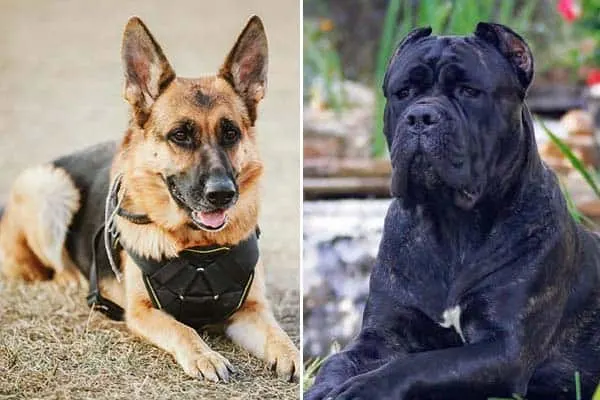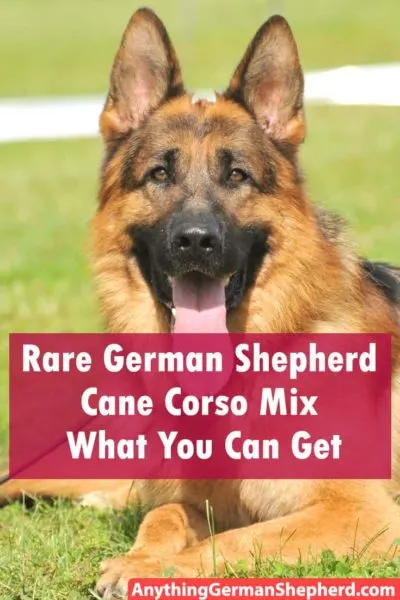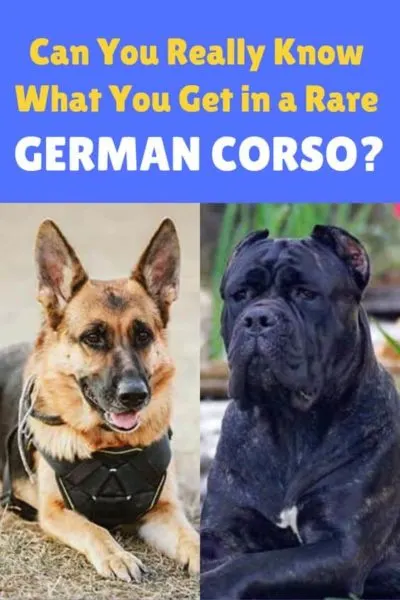The Rare German Shepherd Cane Corso Mix: What Can You Get From This Cross?
Is it safe to say dogs fascinate you? You most certainly have noticed endless comparisons between the most iconic dog breeds.
At the top of many canine web pages, you see German Shepherd vs. Doberman or Pitbull vs. Rottweiler, and lately, German Shepherd vs. Cane Corso.
With the prevalence of designer breeds, have you wondered why you don’t see much on mixing these breeds? What would one of these hybrids even entail?
For instance, how would you describe a cane Corso GSD mix?
A German Shepherd Cane Corso mix, also known as a German Corso, is a mix between two reasonably similar working-type dogs who also have exceptional guarding abilities.
Since it is not a standard cross, much of what we surmise about the German Corso, we base on what we speculate might pass down from the purebred parent breeds.
Prediction is easy when the traits between the breeds are similar, like size and temperament. Color, coat, and health issues are much more challenging to picture ahead of time.

What background does each foundation breed bring to German Corsos?
The german shepherd brings a German tradition of purity
Bred originally as one of several sheep-herding types in Germany in 1899, the German Shepherd gained AKC recognition in 1908.
With uncanny foresight, Max von Stephanitz anticipated a decline in the demand for sheepdogs and made a mission out of creating one of the most versatile working dogs for future generations.
Where the Phylax Society failed to standardize German dog breeds, Stephanitz succeeded in his development of the Alsatian through an intense breeding program with Hektor Linksrhein as the foundational sire.
To this day, the German Shepherd ranks highly in intelligence, versatility, loyalty, bravery, popularity, beauty, focus, and athleticism.
By AKC standards, the Cane Corso is a new breed from Italy.
Although not recognized by the AKC until 2010, the Cane Corso is an ancient breed.
According to The Spruce and other sources, the Corso’s ancestors date from the first century when the Romans used large italian mastiff type dogs from Greece in their war efforts.
One such massive dog, the now-extinct Molossus, gave rise to a family of modern dogs, including the Cane Corso and the similar Rottweiler.
Cane Corsos remain reliable working dogs, used similarly to German Shepherds in police and military duties.
Their background is more combative than german shepherds as they were used for hunting big game like wild boars and in bodyguard capacities.
Cane Corsos display a nimbleness uncharacteristic of many mastiffs and are notable for their intelligence, loyalty, and fierceness.

A Cane Corso German Shepherd Cross has no absolute look
Do you wonder about what kind of dog you will see when you look at a German Corso? Appearance is one of the more unpredictable outcomes of the german shepherd Corso cross, except for size.
Both the German Shepherd and Cane Corso are large, ranging from 70 to over 100 pounds in weight.
The Cane Corso is slightly larger, sometimes closer to 110 pounds, and standing 24 to 28 inches tall at the shoulder compared to the german shepherd 22 to 26 inches.
You can expect German Corsos to be similarly built and possibly even more massive.
Between the two breeds is a generous array of colors. German Shepherds can be traditionally tan or all black, black, and tan.
They can also sport solid colors such as red or blue, blonde, and white which may or may not come with black markings.
Cane Corsos are blue, black brindle, solid black, or fawn. Considering the predominance of dark colors, you might expect many cane Corso mixes to be black or brindle.
Other traits can vary widely. Genetics affect whether the ears are erect or floppy, the head round, the muzzle long or shortened, the coat plush, and the body square or rectangular.
What does the AKC say about the heritage of the German Corso?
A Cane Corso German Shepherd mix is a dog that brings versatility from not only two vastly different backgrounds but two distinct classifications based on purpose.
Although not recognized by the AKC, we can form certain expectations about the hybrid based on what stands out in the two breeds.
Once upon a time, breed standards grouped a large class of canines into one colossal family known as working dogs. Even before that, all dogs were either sporting or non-sporting.
Working dogs eventually broke from the non-sporting group, distinguished by their ability and willingness to help people in a variety of missions.
Breeders sought physical attributes most suitable for particular tasks over appearance.
The working dog’s capabilities stemmed mostly from his sheer size and strength. Nature has also blessed working dogs with loyalty and intelligence.
Some of their jobs, many of which are still relevant today, were herding, guarding, and hauling.
Herding dogs, like the German Shepherd and Belgian Malinois, split from the working group in 1983.
As you can observe from the german shepherd, herding dogs generally retain working dog traits such as stamina, strength, intelligence, and size.
While color and such features as to whether the ears stand or the coat is thick may vary in a German Corso, you can expect a loyal and smart dog with substance.
These are characteristics she will inherit from the working heritage of both parents.

Does the German Corso Make an excellent family pet?
With a German Shepherd Cane Corso hybrid, you are guaranteed to have a large dog that requires early socialization and consistent proper training.
She will likely be loyal to the immediate family and, with a good upbringing, is an affectionate dog, great around children and will be a wonderful family pet after some breed appropriate training.
She may have a variable tendency to prefer one family member like dog owner #over others.
What are the grooming needs of a Cane Corso and German Shepherd mix?
Puppies from a German Shepherd Cane Corso crossing will be highly unpredictable concerning appearance and coat type.
They may have the medium or long-haired double coat of a german shepherd or the short rough fur of a Cane Corso.
Coat length and thickness will, of course, influence grooming requirements. Expect an undercoat of varying thickness, since both parents usually have one.
If your dog has a short coat, you will need to brush him at least once a week. Bathing depends on how soiled he becomes, but most short-haired dogs require washing every six months.
Dog owners frequently bathe their dogs at least monthly.
All dogs require you to clean their ears and trim their nails. If your dog has floppy ears, you will need to pay more attention to the potential for infections.
Long-haired dogs need more frequent brushing, especially if they experience substantial coat loss with seasonal changes.
Dogs with a thick undercoat require more effort to rinse all shampoo out and to completely dry.
Your German Corso will likely be weather-resistant in cold or hot weather. German Shepherds have a classic thick double coat made for frigid temperatures and adaptable to hot conditions.
Cane Corsos have an undercoat sufficient for the cold and with water-resistant qualities. A large size helps reduce the loss of body heat.
Is German Corsos easy to train?
Combine the easy trainability of the German Shepherd with the eagerness of the Cane Corso to please, and you should have a relatively easy time educating your german Corso puppy.
You can have varying degrees of a headstrong personality from the mastiff-type Cane Corso background and challenges to your authority from the Shepherd when training dogs like these.
Both dogs learn quickly and have high retention. They also need mental stimulation along with consistent firmness.
German Corsos can be especially challenging for beginners because of their strength.
Inadequate training can lead to aggression and biting, while improper socialization can produce an anxious, bored, and destructive pet.
German Shepherd Cane Corso crosses make good guard dogs.
Given the natures of the parent breeds, a German Corso is likely to be very protective of family and property.
Both Corsos and Shepherds are naturally distrusting of strangers. Cane Corsos, in particular, can be outright hostile to your guests.
However, a well-behaved German Corso is discerning and should treat most visitors with reserved friendliness.
Even without formal guard-type proper training, your German Corso will likely announce visitors and intruders with loud and formidable barking.
The parent breeds do not bark excessively unless deprived of your presence for extended periods or otherwise bored. You should expect similar behavior from A german shepherd Cane Corso mix.
How much exercise does a German Shepherd Cane Corso need?
According to an article by veterinarian source Vetstreet, Cane Corsos should receive about 45 minutes of exercise each day, including 15 to 20 minutes of formal training.
More than one source, including PDSA (People’s Dispensary for Sick Animals)in the UK, German Shepherds need up to two hours of exercise a day.
Assuming your German Corso has exercise requirements between those of a German Shepherd and a Cane Corso, count on providing your dog an hour to an hour and a half of meaningful activities daily.
An exercise routine should include time set aside for training as well as periods of vigorous exertion such as running and playing. Interactive toys work well, as do puzzles that will exercise your dog’s mind.
Can you have other pets with a German Corso?
Both the german shepherd and Cane Corso have a high prey drive and for the most part, should not be trusted around small animals such as cats and little dogs.
Cane Corsos, in particular, tend to pursue and kill other animals. Your German Corso will likely have a combination of hunting and herding instincts.
Cane Corsos can become acclimated to large dogs in the household. Some even play well at dog parks. However, many Cane Corsos are indifferent to other dogs.
German Shepherds are often friendly with medium and large dogs.
It is difficult to determine where a Corso Shepherd may fall in the spectrum of tolerance for a canine friend.
Your German Corso probably will not be as accepting of breeds of other dogs. However, you cannot underestimate the power of encouraging bond-building at an early age.
What health issues can you expect with a German Corso?
Two health issues have prominence in both a german shepherd dog and Cane Corsos. They are hip dysplasia, a common ailment of a large mixed breed dog, and bloat, a concern for deep-chested dogs.
Your German Corso can display issues other than hip dysplasia. These include any of the issues of either mixed breed dog depending upon her unique composition of conformational features and genetic disease markers.
Cane Corso common problems
- Eyelid abnormalities – entropion whereby the eyelids roll inward and ectropion when they droop outward
- Demodex – a type of mange prevalent in puppies with deficient immunity
- Obesity – Mastiff-types are much more prone to becoming overweight than herding dogs.
German Shepherd specific problems
According to Pet Helpful, a long German Shepherd history of intensive in-breeding may explain why the German Shepherd dog is plagued with more health concerns than the Cane Corso in cane Corso history.
- Eye – Pannus is an immune disorder that affects the cornea.
- Degenerative disc disease – Not dissimilar to the disease process in dachshunds, albeit with different causes, degenerative disc disease can lead to paralysis and debilitation.
- Elbow dysplasia – Similar to hip dysplasia, the elbow grows improperly during puppyhood and causes arthritis later in life.
- Hemophilia – a blood disorder that causes life-threatening bleeding
- Epilepsy – shows up usually in young dogs between one and five years old. Epilepsy is a seizure disorder with an unknown cause associated with certain familial lines.
- Diabetes – not the same as human diabetes; German Shepherds are overrepresented.
Despite their list of health concerns, German Shepherds typically live longer than Cane Corsos.
According to NIH, Cane Corsos live a little over nine years, whereas German Shepherds have an average life expectancy of ten to thirteen years.
Videos help visualization
In this following YouTube Video, a puppy has a bullmastiff also but is still a good representation of how a Shepherd Cane Corso mix might look.
Note the face and hecorso German Shepherd mix are more elongated than a mastiff-type but rounder than a Shepherd. The ears are half-mast and the color is dark brindle, which we and other dog lovers predict to be most common in the mix.
This video illustrates the similarities between german shepherd dogs and Cane Corsos in motion. It gives a realistic image of traits you may see from the cane Corso as related to the tail and ears.
Cane Corsos often present with ears cropped, and tail docked. Note the square shape and classic black and tan color of the german shepherd and how it contrasts with the shorter-built Cane Corso, which has dark brindle coloration.






























